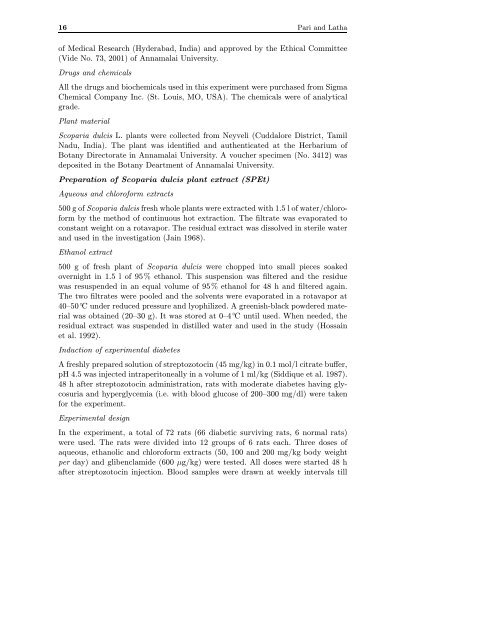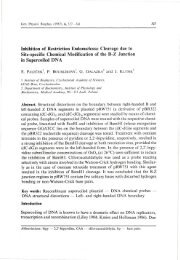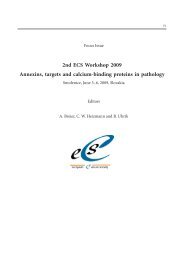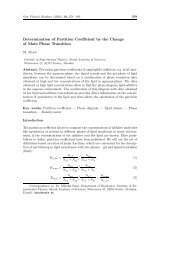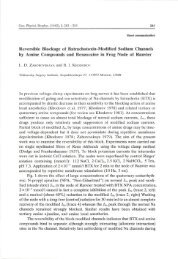Antidiabetic Effect of : Effect on Lipid Peroxidation in - Gpb.sav.sk
Antidiabetic Effect of : Effect on Lipid Peroxidation in - Gpb.sav.sk
Antidiabetic Effect of : Effect on Lipid Peroxidation in - Gpb.sav.sk
You also want an ePaper? Increase the reach of your titles
YUMPU automatically turns print PDFs into web optimized ePapers that Google loves.
16 Pari and Latha<br />
<str<strong>on</strong>g>of</str<strong>on</strong>g> Medical Research (Hyderabad, India) and approved by the Ethical Committee<br />
(Vide No. 73, 2001) <str<strong>on</strong>g>of</str<strong>on</strong>g> Annamalai University.<br />
Drugs and chemicals<br />
All the drugs and biochemicals used <strong>in</strong> this experiment were purchased from Sigma<br />
Chemical Company Inc. (St. Louis, MO, USA). The chemicals were <str<strong>on</strong>g>of</str<strong>on</strong>g> analytical<br />
grade.<br />
Plant material<br />
Scoparia dulcis L. plants were collected from Neyveli (Cuddalore District, Tamil<br />
Nadu, India). The plant was identified and authenticated at the Herbarium <str<strong>on</strong>g>of</str<strong>on</strong>g><br />
Botany Directorate <strong>in</strong> Annamalai University. A voucher specimen (No. 3412) was<br />
deposited <strong>in</strong> the Botany Deartment <str<strong>on</strong>g>of</str<strong>on</strong>g> Annamalai University.<br />
Preparati<strong>on</strong> <str<strong>on</strong>g>of</str<strong>on</strong>g> Scoparia dulcis plant extract (SPEt)<br />
Aqueous and chlor<str<strong>on</strong>g>of</str<strong>on</strong>g>orm extracts<br />
500g<str<strong>on</strong>g>of</str<strong>on</strong>g>Scoparia dulcis fresh whole plants were extracted with 1.5 l <str<strong>on</strong>g>of</str<strong>on</strong>g> water/chlor<str<strong>on</strong>g>of</str<strong>on</strong>g>orm<br />
by the method <str<strong>on</strong>g>of</str<strong>on</strong>g> c<strong>on</strong>t<strong>in</strong>uous hot extracti<strong>on</strong>. The filtrate was evaporated to<br />
c<strong>on</strong>stant weight <strong>on</strong> a rotavapor. The residual extract was dissolved <strong>in</strong> sterile water<br />
and used <strong>in</strong> the <strong>in</strong>vestigati<strong>on</strong> (Ja<strong>in</strong> 1968).<br />
Ethanol extract<br />
500 g <str<strong>on</strong>g>of</str<strong>on</strong>g> fresh plant <str<strong>on</strong>g>of</str<strong>on</strong>g> Scoparia dulcis were chopped <strong>in</strong>to small pieces soaked<br />
overnight <strong>in</strong> 1.5 l <str<strong>on</strong>g>of</str<strong>on</strong>g> 95% ethanol. This suspensi<strong>on</strong> was filtered and the residue<br />
was resuspended <strong>in</strong> an equal volume <str<strong>on</strong>g>of</str<strong>on</strong>g> 95% ethanol for 48 h and filtered aga<strong>in</strong>.<br />
The two filtrates were pooled and the solvents were evaporated <strong>in</strong> a rotavapor at<br />
40–50 ◦ C under reduced pressure and lyophilized. A greenish-black powdered material<br />
was obta<strong>in</strong>ed (20–30 g). It was stored at 0–4 ◦ C until used. When needed, the<br />
residual extract was suspended <strong>in</strong> distilled water and used <strong>in</strong> the study (Hossa<strong>in</strong><br />
et al. 1992).<br />
Inducti<strong>on</strong> <str<strong>on</strong>g>of</str<strong>on</strong>g> experimental diabetes<br />
A freshly prepared soluti<strong>on</strong> <str<strong>on</strong>g>of</str<strong>on</strong>g> streptozotoc<strong>in</strong> (45 mg/kg) <strong>in</strong> 0.1 mol/l citrate buffer,<br />
pH 4.5 was <strong>in</strong>jected <strong>in</strong>traperit<strong>on</strong>eally <strong>in</strong> a volume <str<strong>on</strong>g>of</str<strong>on</strong>g> 1 ml/kg (Siddique et al. 1987).<br />
48 h after streptozotoc<strong>in</strong> adm<strong>in</strong>istrati<strong>on</strong>, rats with moderate diabetes hav<strong>in</strong>g glycosuria<br />
and hyperglycemia (i.e. with blood glucose <str<strong>on</strong>g>of</str<strong>on</strong>g> 200–300 mg/dl) were taken<br />
for the experiment.<br />
Experimental design<br />
In the experiment, a total <str<strong>on</strong>g>of</str<strong>on</strong>g> 72 rats (66 diabetic surviv<strong>in</strong>g rats, 6 normal rats)<br />
were used. The rats were divided <strong>in</strong>to 12 groups <str<strong>on</strong>g>of</str<strong>on</strong>g> 6 rats each. Three doses <str<strong>on</strong>g>of</str<strong>on</strong>g><br />
aqueous, ethanolic and chlor<str<strong>on</strong>g>of</str<strong>on</strong>g>orm extracts (50, 100 and 200 mg/kg body weight<br />
per day) and glibenclamide (600 µg/kg) were tested. All doses were started 48 h<br />
after streptozotoc<strong>in</strong> <strong>in</strong>jecti<strong>on</strong>. Blood samples were drawn at weekly <strong>in</strong>tervals till


